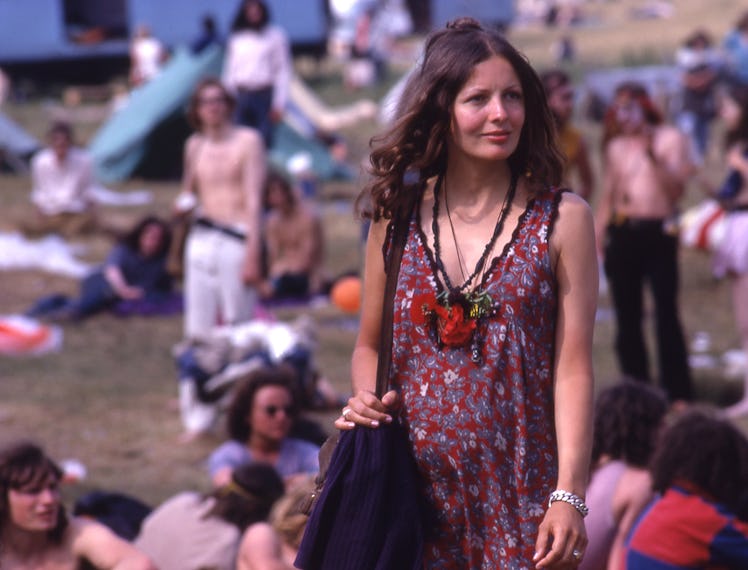Glastonbury Festival Style Has Come a Long Way Since 1971

Today, the Glastonbury festival is a multimillion-dollar operation with sponsored events, activations, and pop-ups surrounding top-billing concerts attended by hundreds of thousands of people. But at one time, the annual event held in Somerset, England was a humble, grassy affair where folks could catch their favorite musicians and have a nice picnic with friends. A new book captures this moment in its history, long before the time period between April and August was officially dubbed “festival season.”
In the Vale of Avalon, available from the publishing house IDEA on May 10, features unreleased photographs from the very first year of Glastonbury Fayre. Photographed by Paul Misso—a British creative who spent the previous six months working on fashion photography in Milan—during a trip to the inaugural festival with film director Nicolas Roeg and the Oscar-winning actress Julie Christie, the pictures capture a simpler time at the Pyramid Stage. What follows are intimate images of concertgoers running through the fields nude, making art, camping out, and braving the elements. More importantly, though, the book—which IDEA will sell in a limited run of 1,000 copies at Dover Street Market in London—acts as a time capsule, capturing the core of the counter-cultural zeitgeist at its peak. Plus, the project documents the development of the festival over the past 50 years—showing just how much Glastonbury, which will take place this year from June 21-25, has grown into a global phenomenon. Below, a look at the book’s imagery, with additional commentary from Misso himself.
Back in early 1971, when Misso worked as a driver for Julie Christie, he received a call from the actress requesting a ride for her and Roeg “to a festival in the West Country,” he tells W. “Nic was wanting to do a documentary on counter culture, and this festival, Glastonbury Fair, was to be his starting point. He asked Julie because he wanted a famous face in the crowd and he was wooing her to appear in his next project, Don’t Look Now, with Donald Sutherland.”
“She says, ‘Sure, provide me with a camper van, fill it with food and drink, and as Paul is going to be our driver and chaperone, hire him as your stills photographer and give him 250 rolls of color film,’” Misso recalls. Here, he snaps a picture of Christie resting in front of the festival’s main stage.
“So there I am, barreling down the A303 to the Magic Kingdom that is the Glastonbury Festival—which endures to this day,” Misso says of his journey to the grounds, where folks set up tents and vans to camp. Above, the model Jean Shrimpton chats with composer Dee Palmer, costume designer Andrea Galer, and Christie (from left).
“I viewed this project as a very serious assignment, as it was ostensibly about the counter culture we all aspired to be living,” Misso says. “I wanted to attempt to capture that zeitgeist. Having been a moderately successful fashion and advertising photographer to this date, I approached it with the desire to capture some essence of the beauty in all the people, and something of the magic and the light in the Vale of Avalon.”
“I was shooting in color, unlike most of the other photographers whose backgrounds seemed to be in reportage, so my images were different—not necessarily better, but certainly different,” Misso adds. “I shot what looked right, and told that story; you, the audience, can judge the results.”
Shrimpton was one of Misso’s favorite people to photograph during 1971 Glastonbury. “She was with her boyfriend of the time, Heathcote Williams, author of the beautiful book ‘Whale Nation’—two highly delightful souls,” he says. “A special moment was photographing Jean in profile, lit exquisitely by the setting sun, holding her Nikon in some of the most beautiful hands I’ve ever seen.”
When asked to identify a favorite image from the book, though, Misso is not “capable of that,” he says. “I like them all—they’re 50-year-old friends!” But he is particularly fond of the above photo, “with a Rainbow People person clad in tiny briefs, hands outstretched, flowers in his hair, standing in front of a flautist and a few interesting souls. It’s an intriguing image.”
“I showed my selection to Nic and his producer Si Litvinoff on Nic’s birthday in his Chelsea flat in August of that year,” Misso says. “At the end of the slide show, Nic turned to me with what appeared to be tears in his eyes, and said ‘Paul, you got it and I didn’t.’”
“As you can imagine, this elicited very mixed emotions in me: on the one hand, elation at such an accolade from such a brilliant man; but on the other, dejection—as Nic eventually dropped the project, and my images languished in a drawer for years as a result.”
“I don’t know about Coachella or Governors Ball, but I do know about the current Glastonbury Festival of Music and Performing Arts, which I go to pretty much every year on a Press Pass,” Misso says. “Each time I access the festival, I get the same feeling as 1971.”
“I feel very privileged to be entering this Magic Kingdom again, where everyone smiles with their stories and music around campfires, extraordinary ordinary people shining with joy and love abounding,” Misso says. “Sorry, I’m waxing lyrical like some ancient hippy—which, of course, I am.”
“And as in my book, the last word is: ‘It’s a small story, but somehow it is a big-small story.”
The cover of In the Vale of Avalon.
The back cover of In the Vale of Avalon.